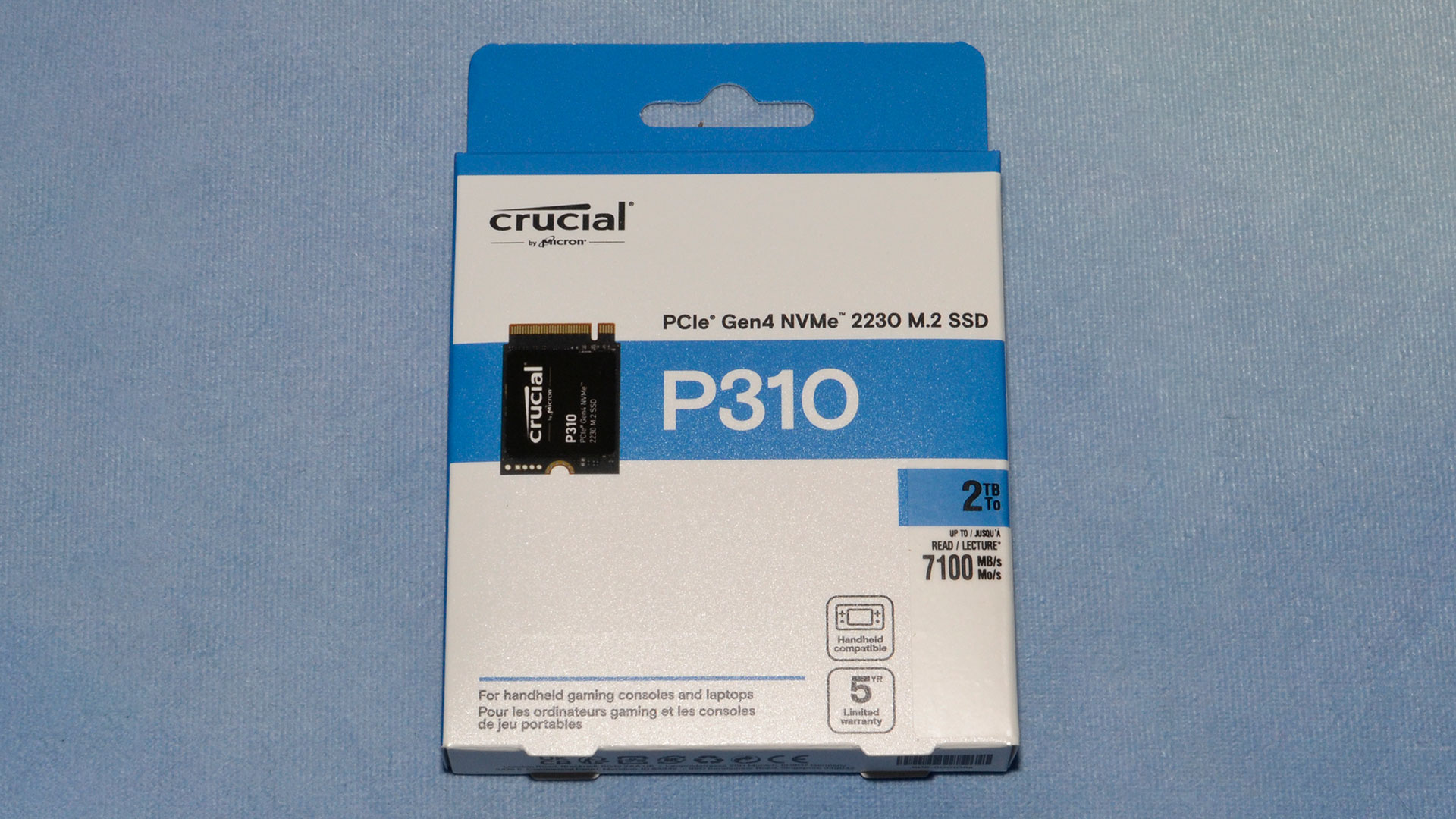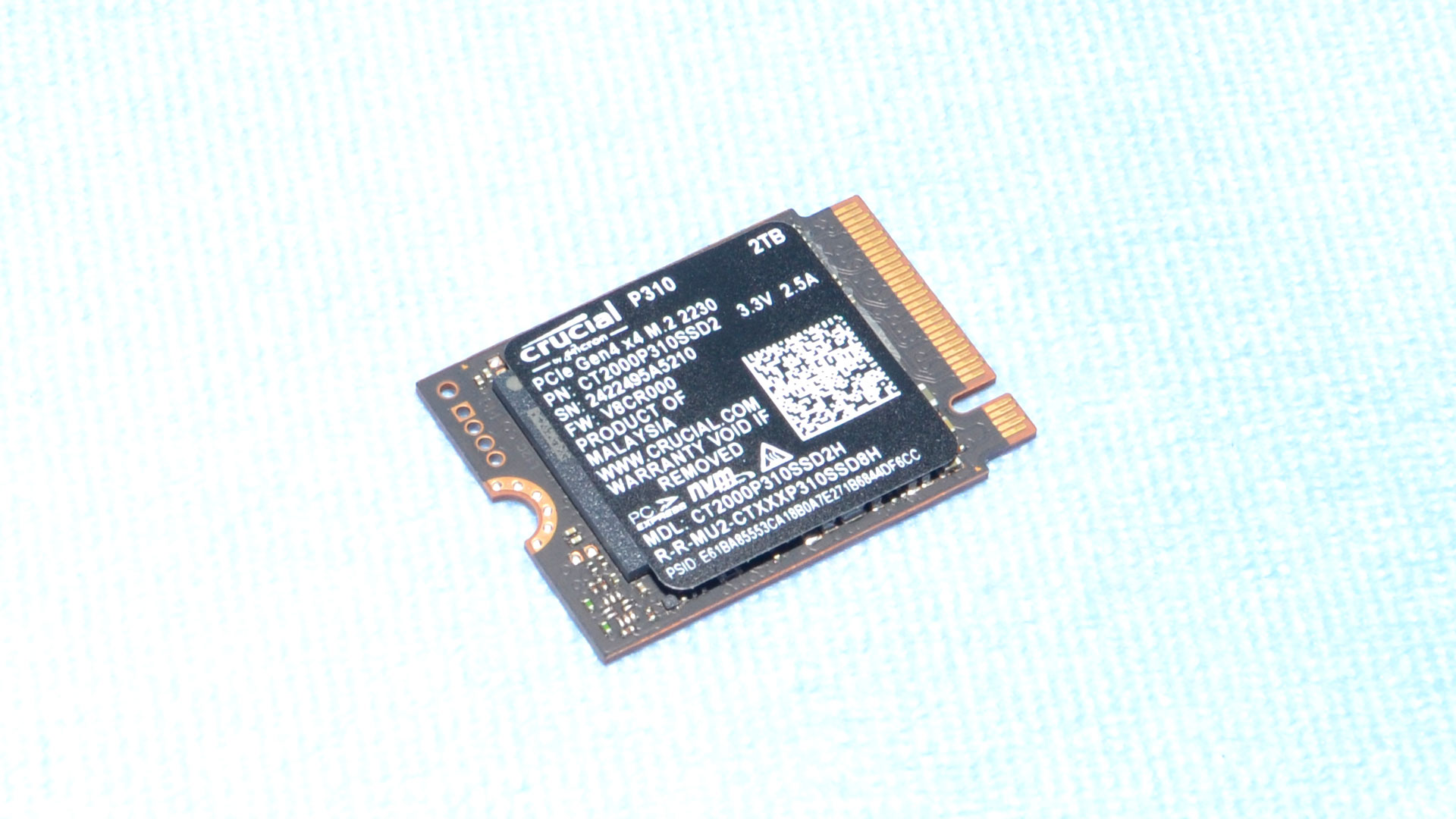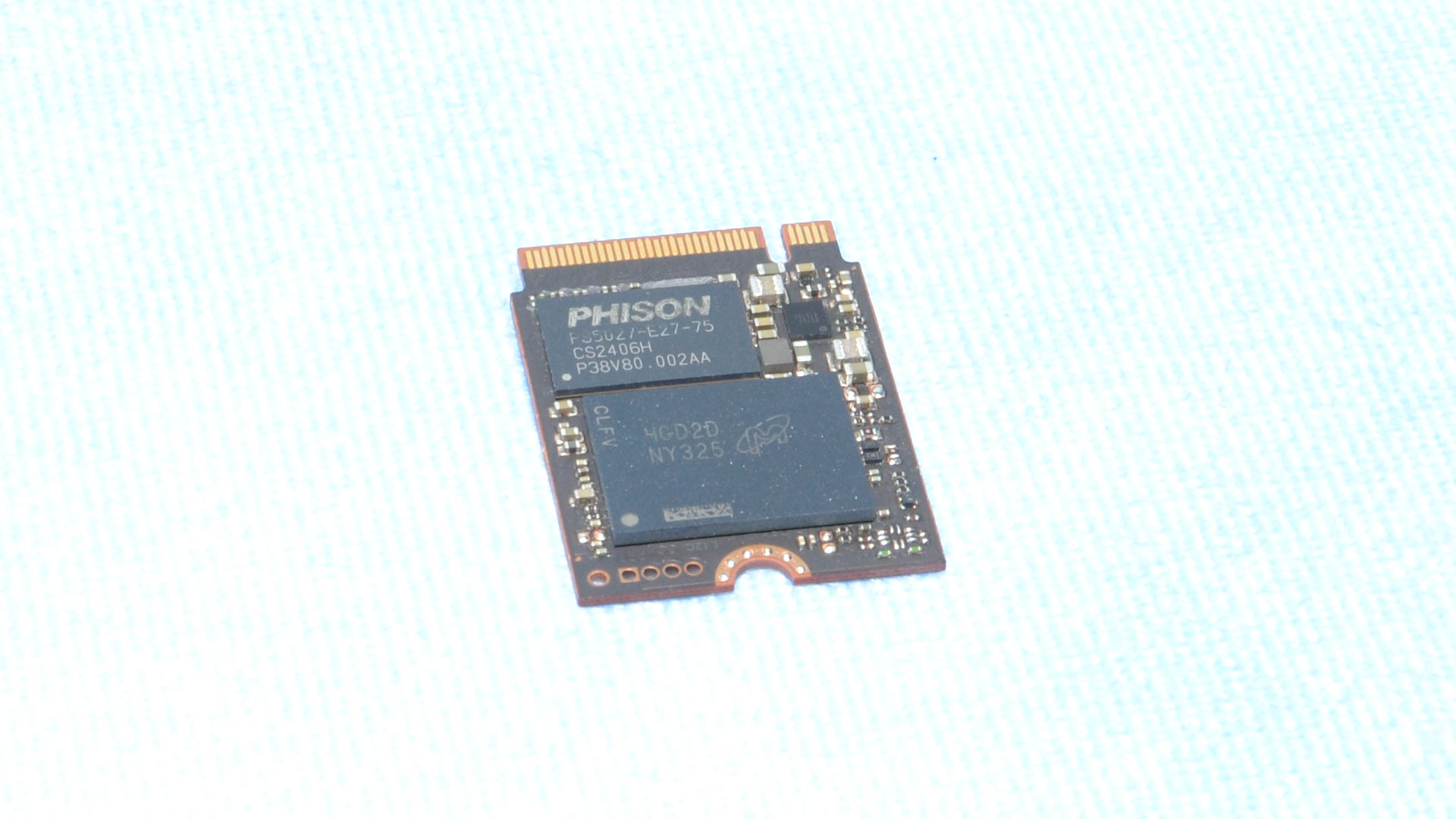Tom's Hardware Verdict
The Crucial P310 is an excellent M.2 2230 SSD, wedding a powerful DRAM-less controller with the newest QLC for surprisingly strong performance and good power efficiency.
Pros
- +
2TB in M.2 2230
- +
Strong all-around performance
- +
Power-efficient
Cons
- -
QLC limitations
Why you can trust Tom's Hardware
The Crucial P310 joins the ranks of M.2 2230 SSDs, which have powered an explosion of mobile gaming and computing systems in recent years. Now’s the time for true high-performance M.2 2230 SSDs, and Crucial intends to lead the way. It already has the fastest consumer SSD on the planet with its T705 and what is probably the best SSD for laptops in the T500 earlier this year, but why stop there? There’s a need for faster 2TB drives in the 2230 form factor, and a good upgrade will last the lifespan of a beloved device. Enter the Crucial P310.
The P310 comes as a bit of a surprise, but a pleasant one. Hot on the heels of the updated Corsair MP600 Mini, which was the fastest SSD in this form factor that we’ve ever tested, comes a QLC-based drive that offers both capacity and performance in one package. Unlike previous alternatives with QLC flash (that's Quad Level Cell, for four bits per cell), the P310 has fewer tradeoffs and a lot of potential. This makes it a great addition if you’re in the market for an M.2 2230 SSD for your laptop or portable gaming system.
Its power efficiency and battery life are both pretty good. Does sustained performance take the predictable nosedive? Yes, but it's not nearly as bad as with past attempts. Does it have any big downsides? Maybe its price tag, but we expect this one will end up a hot seller in due time once street prices correct. There’s a lot of good here, and we’re excited about any advancements for drives in this form factor. This is also the first time we’re working with Micron’s newest QLC flash, so let’s dive into it.
Crucial P310 Specifications
| Product | 1TB | 2TB |
|---|---|---|
| Pricing | $114.99 | $214.99 |
| Form Factor | M.2 2230 | M.2 2230 |
| Interface / Protocol | PCIe 4.0 x4 / NVMe 2.0 | PCIe 4.0 x4 / NVMe 2.0 |
| Controller | Phison E27T | Phison E27T |
| DRAM | N/A (HMB) | N/A (HMB) |
| Flash Memory | 232-Layer Micron QLC | 232-Layer Micron QLC |
| Sequential Read | 7,100 MB/s | 7,100 MB/s |
| Sequential Write | 6,000 MB/s | 6,000 MB/s |
| Random Read | 1,000K IOPS | 1,000K IOPS |
| Random Write | 1,200K IOPS | 1,200K IOPS |
| Security | TCG Pyrite | TCG Pyrite |
| Endurance (TBW) | 220 TB | 440 TB |
| Part Number | CT1000P310SSD2 | CT2000P310SSD2 |
| Warranty | 5-Year | 5-Year |
The Crucial P310 is available in 1TB and 2TB capacities with a respective MSRP of $114.99 and $214.99. These prices are potentially a little bit on the high side as you can get a drive with TLC flash at 1TB for less than $100 and QLC flash at 2TB for as little as $140. Probably the best comparison would be at 2TB, the most desirable capacity these days, against other drives with an equivalent controller. That would be the Corsair MP600 Mini (E27T) that has TLC flash and, at the time of this review, is available for $229.99. This suggests Crucial will probably sell this for below MSRP before long.
Performance on the P310 looks good as it can reach up to 7,100 / 6,000 MB/s for sequential reads and writes at either capacity. The drive can also reach up to 1,000K / 1,200K random read and write IOPS at both capacities, which would have been unthinkable for a DRAM-less drive a couple of years back.
The five year warranty allows for 220TB of writes per TB of capacity, which is very much on the low side compared to modern TLC offerings but within the expected range for QLC flash at 0.12 drive writes per day. This might be a dealbreaker for some, but we think it’s sufficient for the intended use — you'd have to uninstall and install a lot of games over five years to come anywhere near that level of writes.
Crucial P310 Software and Accessories
Crucial offers two primary downloads for SSDs on its website: True Image for Crucial and the Crucial Storage Executive. The former is an OEM tool useful for cloning, imaging, and backing up data for drive migration. The latter is Crucial’s SSD toolbox that shows drive health, enables firmware updates, and contains useful features for drive maintenance and operation. This is better than what you get with OEM drives but is not necessarily a selling point on its own.
Of course if you're planning to use this purely in a Steam Deck, neither tool is particularly useful unless you also plan to run Windows on the device. You could potentially clone your existing SSD using a desktop PC, but firmware updates aren't available via Linux.
Crucial P310 : A Closer Look




The Crucial P310 is a single-sided drive in the M.2 2230 form factor. This makes it particularly useful for portable devices like the Steam Deck, Steam Deck OLED, Asus ROG Ally, and more. Crucial specifically lists the MSI Claw, Microsoft Surface, and some Dell laptops as also being compatible, but for the Surface we would recommend it only for the Pro 9 and newer due to issues with PCIe 4.0 drives on earlier Surface models.
The label indicates a potential power draw of up to or over 8.5W, given 3.3V and up to 2.5A, but the peak power state by SMART is set at 6.30W. There should be no problem using this in any of the above devices, or in other laptops and desktops with an appropriate standoff or with an M.2 extender.
The P310 uses Phison’s newer E27T controller, which is DRAM-less but able to use the full bandwidth of the PCIe 4.0 interface. In this way it's an upgrade to the popular E21T, which tops out at around only 5 GB/s or so. We have discussed the technical details of this controller in previous reviews of drives that utilize it — the Inland TN470, Corsair MP600 Elite, and the M.2 2230 refresh of the MP600 Mini. In brief, it’s a powerful and power-efficient controller that works well in this form factor.
We haven’t heard much about the QLC flash, though. This is Micron’s 232-Layer QLC flash, which has some similarities to YMTC’s 232-Layer QLC flash that we reviewed in the HP FX700. For example, both use a quad-plane design rather than the hexa-plane configuration used with the same-generation TLC flash. We won’t get too much into the technical differences between the two QLC flashes, aside from saying that Micron’s design has smaller blocks and more spare data per page, which together could be better for endurance.
It seems that this new QLC flash is also making its way into other Crucial products, like the P3 Plus, which could be beneficial. This flash currently comes in 1Tb dies, so the promise of higher capacities will have to wait a bit longer.
Crucial also states that the drive has integrated power loss immunity, which is not to be confused with power loss protection. The former protects data-at-rest and the latter data-in-flight. This is not an atypical feature for SSDs as they need a way to cope with sudden power loss. This includes rebuilding mapping metadata that was in the host memory buffer, or HMB feature, for DRAM-less NVMe SSDs. Portable devices are designed to handle power drain gracefully but this type of protection could bring extra peace of mind, considering that a drained battery will usually only involve data-at-rest.
MORE: Best SSDs
MORE: How We Test HDDs And SSDs
Get Tom's Hardware's best news and in-depth reviews, straight to your inbox.
MORE: All SSD Content

Shane Downing is a Freelance Reviewer for Tom’s Hardware US, covering consumer storage hardware.
-
SonoraTechnical How can you say it has strong overall performance... and then list QLC limitations as a CON... Seems they've compensated for the 'qlc limitations' by providing strong overall performance....Reply -
JarredWaltonGPU Reply
Because as fast as this drive performs, the same controller with TLC NAND can do better. QLC means lower endurance, often slower writes, and lower sustained writes.SonoraTechnical said:How can you say it has strong overall performance... and then list QLC limitations as a CON... Seems they've compensated for the 'qlc limitations' by providing strong overall performance....
The Corsair MP600 Mini E27T 1TB drive for example has sustained writes of 781 MB/s, compared to 336 MB/s on the P310. A 2TB MP600 could hypothetically double that result (probably not quite that high, but certainly higher than 781 MB/s). -
vijosef Is this real? 6 Gb/second without dram for 100$?Reply
I remember when I ran RAID-0 of hard disks, and I was living dangerously. -
cyrusfox Its all about sustained writes for these small drives that invariable thermal throttle, and truly this one is the worst.Reply
I am surprised it has received such high marks in the summary if you stress it, will slow to slower than a 7200RPM HDD for seq writes.
From what I have seen the SN770M looks to be the best rounded 2230 SSD. For budget I still choos sn740 off aliexpress. QLC native speed needs to be hid behind more pSLC. 70 seconds is much too short of a time to fill cache. -
JarredWaltonGPU Reply
If you want sustained performance, it's more useful to use the bar chart:cyrusfox said:Its all about sustained writes for these small drives that invariable thermal throttle, and truly this one is the worst. I am surprised it has received such high marks in the summary if you stress it, will slow to slower than a 7200RPM HDD for seq writes.
From what I have seen the SN770M looks to be the best rounded 2230 SSD. For budget I still choos sn740 off aliexpress. QLC native speed needs to be hid behind more pSLC. 70 seconds is much too short of a time to fill cache.
As discussed in the review, for a QLC 2TB drive, 400GB of pSLC cache is 1600GB of total space, leaving a final 400GB for QLC use. And the drive sustains 336 MB/s. No hard drive will come anywhere near that mark, not empty and certainly not half full. Literally every other QLC M.2 2230 drive has one third that level of performance after the pSLC cache is full — which a decent HDD could actually beat. Your suggestion that "truly this one is the worst" is completely wrong and shows a gross misunderstanding of the M.2 2230 market.
Yes, the SN770M and SN740 are "better" in sustained performance. But in real-world testing, not write saturation, the P310's new E27T controller and 232-layer QLC NAND often beats those drives. It's at or near the top in virtually every other test. You've basically picked the one weak element and decided to elevate that to being the most important aspect.
If you're putting this into a gaming handheld, which is the most likely scenario, this is an excellent choice (assuming pricing comes down to where it ought to be). If you have a device that can take 2242 or even 2280 form factor, then there are dozens of SSDs that will be a far better choice. -
cyrusfox Reply
I prefer the hysteresis shown when zoomed in, obvious that SN740 is not tuned well initially, interesting that it wins at the 15 minute mark.JarredWaltonGPU said:If you want sustained performance, it's more useful to use the bar chart:
There are some HDD which do offer 400+MB/s sustained write performance, odd niche, and you are right, it is not the norm. Also I am crapping on the drive a little, because it did not surpass WD efforts, same has been true since the beginning of 2230 drives (WD SN520/530 easily best Micron's 2100 to the 2450). Micron firmware updates may help, they helped a bit with 2100 but that is still a hot running 2230 drive.JarredWaltonGPU said:As discussed in the review, for a QLC 2TB drive, 400GB of pSLC cache is 1600GB of total space, leaving a final 400GB for QLC use. And the drive sustains 336 MB/s. No hard drive will come anywhere near that mark, not empty and certainly not half full. Literally every other QLC M.2 2230 drive has one third that level of performance after the pSLC cache is full — which a decent HDD could actually beat. Your suggestion that "truly this one is the worst" is completely wrong and shows a gross misunderstanding of the M.2 2230 market.
All depends on the intended use case, for a handhed maybe this is great(but is it perceptibly better than the lowest grade 2230? Handhelds IO are they even capable of maintaining full IO stress themselves?)JarredWaltonGPU said:Yes, the SN770M and SN740 are "better" in sustained performance. But in real-world testing, not write saturation, the P310's new E27T controller and 232-layer QLC NAND often beats those drives. It's at or near the top in virtually every other test. You've basically picked the one weak element and decided to elevate that to being the most important aspect.
If you're putting this into a gaming handheld, which is the most likely scenario, this is an excellent choice (assuming pricing comes down to where it ought to be). If you have a device that can take 2242 or even 2280 form factor, then there are dozens of SSDs that will be a far better choice.
My use case is CFeB adapters, and the only factor of importance there is sustained write speed, Don't care about gen 4 speeds, or how well it burst, but how does it hold up when the cache runs dry and/or the thermals go out of bounds. 2230 thermals are always going to be important, and I am quite sensitive if it can't perform long enough with a required data write rate. -
JarredWaltonGPU Reply
Oh yeah, that's a very niche use case and I can totally see why overheating and throttling would become a serious issue there. I suspect the E27T 2230 drives will throttle less, as they're (I think?) 7nm node compared to 12nm, or maybe it's 12nm instead of 28nm? But higher speed would also make them potentially more likely to throttle. For maximum sustained throughput right now, probably the Corsair MP600 Mini 2TB (E27T) model would be what you'd want. We're working to get one of those for testing, as the sustained throughput (thanks to double the NAND) might be twice as high as the 1TB drive, give or take.cyrusfox said:My use case is CFeB adapters, and the only factor of importance there is sustained write speed, Don't care about gen 4 speeds, or how well it burst, but how does it hold up when the cache runs dry and/or the thermals go out of bounds. 2230 thermals are always going to be important, and I am quite sensitive if it can't perform long enough with a required data write rate. -
Notton 2230 is an interesting market.Reply
It's clear end users don't like the size and use adapters to get a 2280 to fit in the device, but the manufacturers love it for some reason.
Any chance of getting the Micron 2400? It seems to be an endurance focused 2230 QLC. -
JarredWaltonGPU Reply
We would have to purchase one, and while the 2TB has 600TB of endurance, it also has a 3-year (instead of 5-year) warranty. It’s a first gen PCIe 4.0 2230 QLC drive as well, often used by ORMs in laptops. I’d expect it to perform about the same as the various E21T QLC drives we’ve tested, even though it uses a different SM2269XT controller.Notton said:Any chance of getting the Micron 2400? It seems to be an endurance focused 2230 QLC.
